

Most ebook files are in PDF format, so you can easily read them using various software such as Foxit Reader or directly on the Google Chrome browser.
Some ebook files are released by publishers in other formats such as .awz, .mobi, .epub, .fb2, etc. You may need to install specific software to read these formats on mobile/PC, such as Calibre.
Please read the tutorial at this link: https://ebookbell.com/faq
We offer FREE conversion to the popular formats you request; however, this may take some time. Therefore, right after payment, please email us, and we will try to provide the service as quickly as possible.
For some exceptional file formats or broken links (if any), please refrain from opening any disputes. Instead, email us first, and we will try to assist within a maximum of 6 hours.
EbookBell Team

4.7
16 reviewsMany elements and inorganic compounds play an extraordinary role in daily life for numerous applications, e. g., construction materials, inorganic pigments, inorganic coatings, steel, glass, technical gases, energy storage and conversion materials, fertilizers, homogeneous and heterogeneous catalysts, photofunctional materials, semiconductors, superconductors, soft- and hard magnets, technical ceramics, hard materials, or biomedical and bioactive materials. The present book is written by experienced authors who give a comprehensive overview on the many chemical and physico-chemical aspects related to application of inorganic compounds and materials in order to introduce senior undergraduate and postgraduate students (chemists, physicists, materials scientists, engineers) into this broad field.
Volume 3 presents electronic, magnetic, biomedical, carbon- and sulfur-based materials and ceramics.
Vol. 1. From Construction Materials to Technical Gases.
Vol. 2. From Energy Storage to Photofunctional Materials.